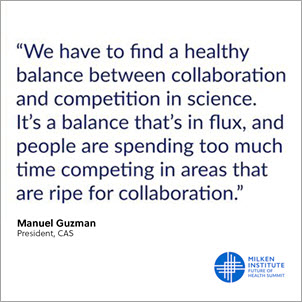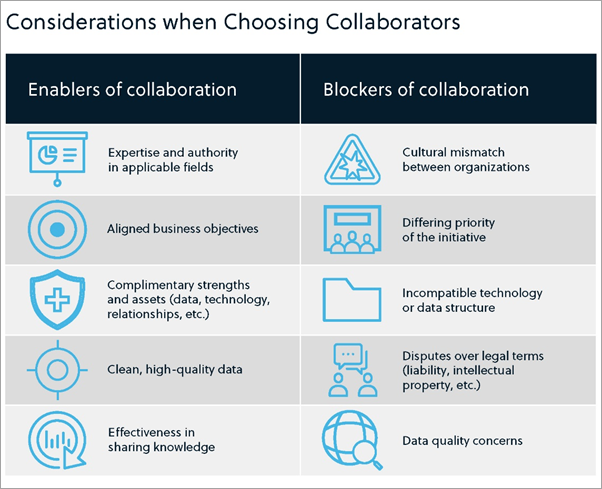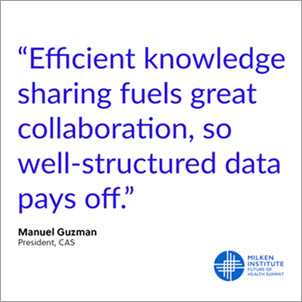I recently had the honor of joining a panel of global experts at the Milken Institute Future of Health Summit to discuss the value of collaboration in speeding scientific discovery. For their annual Future of Health event, the Milken Institute brings together the world’s leading minds from across the spectrum of healthcare to address our most significant challenges and work towards solutions. On this panel, we discussed opportunities to build on the learnings from COVID-19 research to better enable collaboration and accelerate progress.
The scientific community’s unprecedented response to the pandemic illustrates how rapidly breakthroughs and innovations can be achieved by engaging in collaboration at the optimal time in the discovery process. Our team at CAS is proud to have contributed to these collaborative efforts by publishing resources including peer-reviewed articles, sharing expertise from our scientific teams, and releasing relevant data collections. This included an open-access dataset of nearly 50,000 compounds with known or potential antiviral activity that is supporting research, data mining and analytics applications.
Though we often think of scientific discovery as being driven by competition, going forward, one of the key questions is how we can achieve the optimal balance between collaboration and competition to enhance scientific innovation.

Open collaboration makes sense in the early stages of innovation, where the focus is on basic research to understand the underlying science. At this point, sharing information and insights is extremely valuable to accelerate progress. Expediting foundational understanding of the challenge or opportunity is particularly critical in urgent cases, such as COVID-19.
When efforts shift to finding solutions, ethical competition can drive urgency and encourage a broader range of innovation outcomes. This is demonstrated by the 174 unique COVID-19 vaccine candidates currently in clinical or pre-clinical testing. In the solution phase, competition promotes the diversity of thought needed to overcome complex problems and guards against “groupthink” that can hinder creative problem-solving. Thus, collaboration in this phase is usually more limited and focused on addressing gaps in technology, expertise, data, or even funding that hinder further progressing a promising solution.
Forging successful collaborations is no easy feat. Estimates suggest that up to 70% of collaborations across sectors fail to deliver on their intended outcomes, so there is plenty of opportunity for new approaches.
Identifying the right partners with the necessary assets and aligned objectives remains a major challenge. First, potential collaborators must have clarity about what gaps they are looking for a partner to help fill and what unique strengths their organization has to contribute. This allows for objective assessment of the strategic and functional fit of possible partners.
The following are key enablers and barriers to collaboration that innovators should think about when vetting potential partners:

Given the importance of selecting the right partners, one high-impact opportunity to enable greater collaboration is to establish more systematic ways for innovators to connect with synergistic organizations aligned with their goals, needs, and values.
One example is The Pistoia Alliance, a global, not-for-profit organization of more than 100 member companies, including the world’s largest pharmaceutical companies, focused on lowering the barriers to innovation through pre-competitive collaboration in the life science community. The alliance structure provides a legal framework to enable straightforward and secure on-going collaboration on technology, regulatory, safety, clinical, and data governance opportunities. This pre-competitive collaborative approach reduces costs and speeds progress of bringing innovations to market, while supporting development of technology and resources that benefit the broader life science community.
Data are becoming one of the most important strategic assets enabling effective collaboration as the importance of technologies such as AI and predictive modeling in scientific research grows. The quality and compatibility of collaborators’ data can greatly accelerate or hinder such projects, making it an important criteria to consider when selecting partners. To enable greater collaboration, increased investment in knowledge management and technology infrastructure will likely be necessary given the rapidly growing volume of scientific data and emerging technology opportunities.

Developing neutral platforms for open or secure data sharing is another opportunity to enable greater collaboration. One example is CORD-19, a COVID-19 open research dataset compiled by The Allen Institute for AI, in partnership with leading research groups and U.S. government agencies, to support sharing the latest COVID-19 data and publications. A platform approach such as this allows the costs of data management, security, technology, and other infrastructure to be shared by collaborators or covered publicly or philanthropically.
The unprecedented speed of COVID-19 therapeutics development has clearly demonstrated the ROI on increasing global collaboration to accelerate scientific progress. As a trusted leader in scientific information solutions, CAS is proud to enable this collaboration by curating, connecting, and analyzing the world’s largest collection of published science and making those insights available to innovators around the world.
Is your organization collaboration ready? Enhancing your data assets and knowledge management strategy is a critical first step. Learn how CAS can help.
President, CAS